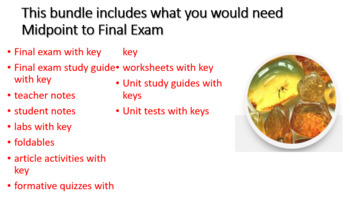Zoology 2nd half Bundle: Chordates, Animal Behavior
Zoology Shop
86 Followers
Grade Levels
9th - 12th, Higher Education
Subjects
Resource Type
Standards
NGSSHS-LS4-2
NGSSHS-LS4-1
NGSSHS-LS4-6
NGSSHS-ESS3-1
NGSSHS-LS4-3
Formats Included
- Zip
Zoology Shop
86 Followers
Products in this Bundle (41)
showing 1-5 of 41 products
Bonus
Zoology Curriculum Map
Also included in
- This bundle includes what you would need for a full course of Zoology. Includessyllabus unit planspacing guidezoology pretest with keyFinal exam with keyFinal exam study guide with keyteacher notes student notes labs with keyfoldablesarticle activities with keyformative quizzes with keyworksheets wiPrice $860.58Original Price $1075.73Save $215.15
Description
Post Midterm Zoology
Notes
Tests
study Guides
Total Pages
Answer Key
Included
Teaching Duration
N/A
Report this resource to TPT
Reported resources will be reviewed by our team. Report this resource to let us know if this resource violates TPT’s content guidelines.
Standards
to see state-specific standards (only available in the US).
NGSSHS-LS4-2
Construct an explanation based on evidence that the process of evolution primarily results from four factors: (1) the potential for a species to increase in number, (2) the heritable genetic variation of individuals in a species due to mutation and sexual reproduction, (3) competition for limited resources, and (4) the proliferation of those organisms that are better able to survive and reproduce in the environment. Emphasis is on using evidence to explain the influence each of the four factors has on number of organisms, behaviors, morphology, or physiology in terms of ability to compete for limited resources and subsequent survival of individuals and adaptation of species. Examples of evidence could include mathematical models such as simple distribution graphs and proportional reasoning. Assessment does not include other mechanisms of evolution, such as genetic drift, gene flow through migration, and co-evolution.
NGSSHS-LS4-1
Communicate scientific information that common ancestry and biological evolution are supported by multiple lines of empirical evidence. Emphasis is on a conceptual understanding of the role each line of evidence has relating to common ancestry and biological evolution. Examples of evidence could include similarities in DNA sequences, anatomical structures, and order of appearance of structures in embryological development.
NGSSHS-LS4-6
Create or revise a simulation to test a solution to mitigate adverse impacts of human activity on biodiversity. Emphasis is on testing solutions for a proposed problem related to threatened or endangered species, or to genetic variation of organisms for multiple species.
NGSSHS-ESS3-1
Construct an explanation based on evidence for how the availability of natural resources, occurrence of natural hazards, and changes in climate have influenced human activity. Examples of key natural resources include access to fresh water (such as rivers, lakes, and groundwater), regions of fertile soils such as river deltas, and high concentrations of minerals and fossil fuels. Examples of natural hazards can be from interior processes (such as volcanic eruptions and earthquakes), surface processes (such as tsunamis, mass wasting and soil erosion), and severe weather (such as hurricanes, floods, and droughts). Examples of the results of changes in climate that can affect populations or drive mass migrations include changes to sea level, regional patterns of temperature and precipitation, and the types of crops and livestock that can be raised.
NGSSHS-LS4-3
Apply concepts of statistics and probability to support explanations that organisms with an advantageous heritable trait tend to increase in proportion to organisms lacking this trait. Emphasis is on analyzing shifts in numerical distribution of traits and using these shifts as evidence to support explanations. Assessment is limited to basic statistical and graphical analysis. Assessment does not include allele frequency calculations.



